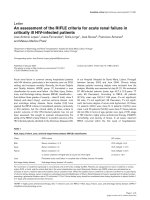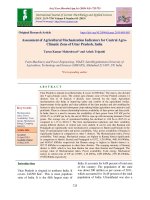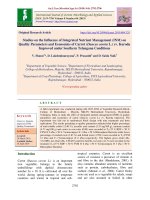Assessment of seed priming methods for seed quality parameters in chilli (Capsicum annuum L.) seeds
Bạn đang xem bản rút gọn của tài liệu. Xem và tải ngay bản đầy đủ của tài liệu tại đây (204.9 KB, 5 trang )
Int.J.Curr.Microbiol.App.Sci (2018) 7(7): 3866-3870
International Journal of Current Microbiology and Applied Sciences
ISSN: 2319-7706 Volume 7 Number 07 (2018)
Journal homepage:
Original Research Article
/>
Assessment of Seed Priming Methods for Seed Quality Parameters
in Chilli (Capsicum annuum L.) Seeds
Vishal Kumar1*, A.K. Chaurasia2 and Bineeta M. Bara3
Department of Genetics and Plant Breeding, Naini Agricultural Institute, Sam Higginbottom
University of Agriculture, Technology & Sciences, Allahabad, Uttar Pradesh, India
*Corresponding author
ABSTRACT
Keywords
Chilli seeds,
Hydropriming,
Halopriming,
Osmopriming,
Organic priming
and duration
Article Info
Accepted:
26 June 2018
Available Online:
10 July 2018
An experiment was conducted on priming was conducted in Post Graduate Laboratory,
Department of Genetics and Plant Breeding, Sam Higginbottom University of Agriculture,
Technology & Sciences, SHUATS, Allahabad, Uttar Pradesh during 2017-2018 on Chilli
Kashi Anmol variety. The seeds are treated with different chemicals like Distilled water,
(PEG 20%), (KCl 1%), (CaCl2 1%), (Neem Leaf Extract 5%) and (Eucalyptus Leaf Extract
5%). The treated seeds are soaked for 12hr for seed germination percentage, speed of
germination, shoot length, root length, seedling length, seedling fresh weight and dry
weight, seedling vigour index I and seedling vigour index II, Halopriming with KCl 1%
and CaCl21% soaked to 12hrs. KCl 1% primed seed recorded higher germination percent
(88.75%), speed of germination (16.77), root length (3.42cm), shoot length (5.36cm),
seedling length (8.78cm), seedling fresh weight (2.17 g), seedling dry weight (0.025 g),
seed vigour index I (779.80) and seed vigour II (2.17) the seed treated with KCl 1%
followed by CaCl2 1% recorded numerical higher value compared to control. It was found
that all priming treatment showed significance difference with the control.
Introduction
Chilli (Capsicum annuum L.) belongs to the
family Solanaceae having diploid species with
mostly 2n = 2x = 24 chromosomes, but wild
species with 2n = 2x = 26 chromosomes have
been reported (Pickersgill, 1991). The
domestication of chilli first occurred in
Central America, most likely in Mexico, with
secondary centers in Guatemala and Bulgaria
(Salvador, 2002). India, Mexico, Japan,
Ethiopia, Uganda, Nigeria, Thailand, Turkey,
Indonesia, China and Pakistan are the major
chilli growing countries. To some extent, it is
also grown in Italy, Spain and the United
States.
Broadly, the chillies can be categorized into
hot and mild types based on pungency. In the
world, it is cultivated on an area of 1.98
million hectares with an annual production of
31.132 million tonnes and having the
productivity of 1576.34 kg ha-1. The important
chilli producing countries in the world are
India, China, Indonesia, Korea, Pakistan,
Turkey and Srilanka. The „mild‟ Chilli is
3866
Int.J.Curr.Microbiol.App.Sci (2018) 7(7): 3866-3870
known as paprika and it is produced in
Hungary, Spain, Romania, Bulgaria and
Slovak Republic countries.
In India, Chilli is grown all over the country
under varying agro-climatic zones but area of
riped dry chilli is concentrated in southern
states. In India, the area under this crop is 287
thousand hectares with an annual production
of 3406 thousand MT with productivity of 2.1
kg ha-1(National Horticulture board 2017).
India alone contributes about 50 per cent of
world production, out of which 90 per cent is
used for domestic consumption and only six
per cent is exported to other countries like
USA, Bangladesh, Nepal and Mexico.
Chilli (Capsicum annuum L.) is vernacularly
known as “Mirchi”. It occupies an important
place in daily diet and can be used in a variety
of ways. Chilli fruits are used as pickles,
sauces, ketchup, essence, oleoresins and are an
inevitable ingredient in Indian dishes. Chilli is
a good source of capsicin, vitamin A, vitamin
C, riboflavin and thiamine. It contains about)
carbohydrates, (5.3 g) sugar, (1.9 g) protein
and (534 micro g) beta carotene per 100 g
chill (Panda et al., 2010).
The Chilli fruits are used for imparting
pungency both at green stage as well as after
maturity. The fruit varies in size from 1-20 cm
in length from thin, long to conical and thick
fleshed blocky 39 shapes. The popularity of
chilli is due to its wide range of shape, size
and sensory attributes such as colour,
pungency and piquancy that make generally
insipid bulk nutritive flesh, cereal and
vegetable
foods
more
appetizing
(Govindarajan et al., 1987).
High quality seed is the key to successful
agriculture. Modern agriculture with its bias
for technology and precision, demands that
each and every seed should germinate and
produce a vigorous seedling ensuring high
yield. Apart from increased productivity, the
seeds should also have better storability to
produce good crop during the next season. To
accomplish these characters the seed
technologists
have
developed
seed
invigoration techniques such as seed priming
which has significant impact on seed quality.
Seed priming is a commercially viable
technique for improving seed germination and
vigour. It involves imbibition of seeds in water
under controlled conditions to initiate early
events of germination, followed by drying the
seed back to its initial moisture content (Dolly
pan and Basu, 1985).
Priming in its traditional sense, soaking of
seeds in water before sowing, has been the
experience of farmers in India in an attempt to
improve crop stand establishment but the
practice was without the knowledge of the
safe limit of soaking duration (Harris et al.,
1999).
The main objectives include, to evaluate the
effect of different priming method on seedling
parameters in chilli. And also to identify best
priming method for chilli seeds.
Materials and Methods
The present study entitled “Assessment of
Seed Priming Methods for Seed Quality
Parameters in Chilli(Capsicum annuum L.)
Seeds” under Post graduate laboratory of Seed
Science and Technology was conducted in the
Department of Genetics and Plant breeding,
Naini
Agricultural
Institute,
Sam
Higginbottom University of Agriculture,
Technology and Sciences, Allahabad during
2017-2018. The lab experiment was analyzed
by using C.R.D. (Complete Randomized
Design) with 4 replications and 7 treatments
under laboratory condition. Seed Treated with
Control
(untreated),
Distilled
water,
Polyethylene glycol (PEG 20%), Potassium
chloride
(KCl1%),
Calcium
chloride
(CaCl21%), Neem Leaf Extract (5%) and
Eucalyptus Leaf Extract (5%) soaking for 12
3867
Int.J.Curr.Microbiol.App.Sci (2018) 7(7): 3866-3870
hrs. Afterward, primed seeds were allowed to
dry back to their original moisture content
under shade to assess the parameters.
The observation on the characters viz.,
Germination percent (ISTA 2004), Speed of
germination, Root length (cm), Shoot length
(cm), Seedling length (cm), Seedling fresh
weight (g), Seedling dry weight (g), Seedling
vigour index I and Seedling vigour index
II(Baki and Anderson, 1973) were recorded.
The experimental data recorded were
subjected to statistical analysis for calculating
analysis of variance, range, and mean, critical
Difference and coefficient of variation (Fisher,
1936).
Results and Discussion
According to the results, all studied traits were
affected by the treatments and there was
completely significant difference between
control (unprimed seeds) and primed seeds
(Table 1). All seedling characters were
affected by KCl - 1% and it was followed by
T3–CaCl2 with 653.37 and T1–Distilled water
are significantly recorded maximum (Table 2).
The results are conformity with findings of
(Kalyanrao et al., 2017). Significantly higher
germination percent (88.75) reported in
treatment T3 - KCl- 1% followed by T4 CaCl21% (87.25) and T2 - PEG(20%) (85.00).
Higher Speed of Germination reported in T3 KCl-1% (16.77) followed by T4–CaCl2
(15.22) and T1–Distilled water (14.70).
Maximum root length (3.42cm) was recorded
by T3 and it was followed by T4with (3.14cm)
and T1with (2.91cm). Maximum shoot length
(5.36cm) was recorded by T3 and it was
followed by T4(4.36cm) and T1(4.11cm). The
results are conformity with findings of
(Nasher 2008).
Maximum seedling length (8.78 cm) found in
T3 and it was followed by T4(7.50 cm) and
T1(6.98 cm) and minimum seedling length in
T0(5.94). Maximum Fresh weight (2.17gm)
was recorded by T3with treatment of KCl-1%.
Maximum dry weight (0.025gm) was recorded
by T3with treatment of KCl- 1%. Maximum
vigour index - I (779.80) was recorded by KCl
- 1% and it was followed by CaCl2 1% with
653.37 and Distilled water with 590.50.
Maximum vigour index – II (2.17) was
recorded by T3 and it was followed by
T4(1.63) and T1(1.56). Minimum seedling
characters were observed in control (T0) and
(T6) 400C.
Table.1 Analysis of variance for vigour characters in chilli (capsicum annuum L.)
Sl.
No.
Characters
1
2
3
4
5
6
7
8
9
Germination percentage
Speed of germination
Root length (cm)
Shoot length (cm)
Seedling length (cm)
Seedling fresh weight (g)
Seedling dry weight (g)
Seedling Vigour index I
Seedling Vigour index II
Mean sum of squares
Treatment
Error
(d.f. =6)
(d.f.=21)
74.583*
4.786
7.943*
1.580
0.354*
0.281
2.166*
0.192
4.118*
0.514
0.105*
0.074
0.138*
0.116
48461.998*
3455.013
0.469*
0.022
*Significant at 5% level
3868
Int.J.Curr.Microbiol.App.Sci (2018) 7(7): 3866-3870
Table.2 Mean performance of chilli for 9 seedling characters
Treatments
Germination
percentage
Speed of
germination
Root
length
(cm)
Shoot
length
(cm)
Seedling
length
(cm)
Seedling fresh
weight
(g)
Seedling dry
weight
(g)
Seedling
Vigour
index I
Seedling
Vigour
index II
T0
75.25
12.52
2.59
3.39
5.94
1.65
0.014
447.20
1.03
T1
84.75
14.70
2.91
4.11
6.98
1.86
0.019
590.50
1.56
T2
85.00
14.20
2.64
3.47
6.12
1.82
0.018
520.43
1.48
T3
88.75
16.77
3.42
5.36
8.78
2.17
0.025
779.80
2.17
T4
87.25
15.22
3.14
4.36
7.50
1.87
0.019
653.37
1.63
T5
83.75
14.10
2.81
3.43
6.24
1.82
0.018
522.68
1.46
T6
83.25
13.02
2.70
3.44
6.32
1.74
0.017
526.47
1.37
Grand mean
84
14.36
2.88
3.94
6.84
1.85
0.018
577.20
1.53
C.D @5%
3.23
1.86
0.62
0.64
1.06
0.08
0.003
87.01
0.22
S.E.M
1.09
0.62
0.26
0.21
0.35
0.03
0.001
29.39
0.07
C.V.
2.60
8.75
18.35
11.12
10.47
3.26
10.24
10.18
9.75
Max.
88.75
16.77
3.42
5.36
8.78
2.17
0.025
779.8
2.17
Min.
75.25
12.52
2.59
3.39
5.94
1.65
0.014
447.20
1.03
3869
Int.J.Curr.Microbiol.App.Sci (2018) 7(7): 3866-3870
On the basis of results obtained from the present
experiment following conclusions are drawn.
The different priming treatments showed
significant
Halopriming
increases
the
germinability and vigour of chilli seeds,
significantly in lab condition. Potassium
Chloride KCl (1%), significantly increased the
germination and vigour of chillis. Halopriming
of the chilli seeds for 12 hrs. enhanced
germinability, vigour of chilli seeds. These
conclusions are based on the results of three
months investigation and therefore further
investigation is needed to arrive at valid
recommendations.
Soaking of seed with Distilled water is
advantageous to obtain healthy seedlings. The
second best option for priming is soaking of
seeds with Calcium Chloride CaCl2 (1%).
Acknowledgements
The authors are thankful to all the members of
the Seed Science and Technology, Department
of Genetics and Plant Breeding, Naini
Agricultural Institute, Sam Higginbottom
University of Agriculture, Technology and
Sciences, Allahabad, U.P., for providing all
necessary facilities and support for research.
References
Abdul-Baki AA, Anderson JD (1773), Vigour
determination in soybean by multiple
criteria. “Crop Science”. 1973; 13:630633.
Dollypan and Basu, R.N. (1985). Mid-storage
and pre-sowing seed treatments for
lettuce and carrot. Scientia Hort. 33(6):
1026-1027.
Govindaranjan, V. S., Rajalakshmi, D., and N.
Chand, (1987). Capsicum production,
technology, chemistry and quality, Part
IV, Evaluation of quality, CRC Crit.
Rev. Food Sci. Nutr.,25:185-283.
Harris, D., Joshi, A., Khan, P.A., Gothkar, P.,
and sodhi, P.S. (1999). On-farm seed
priming in semiarid agriculture:
development and evaluation in maize,
rice and chickpea in India using
participatory methods. Exp. Agric. 35:
15-29.
ISTA (2004). Rules amendments 2001. Seed
Science Technology, 29, supplement 2:
132.
Nasher.H.Samir (2008).The Effect of Magnetic
Water on Growth of Chick-Pea Seeds.
Engineering & Technology Vol. 26,
No.9, 2008
Panda, R., Panda, H., Prakash, K., and Panda,
A. (2010). Prospects of Indian Chillies.
Science tech entrepreneur, pp. 8.
Pickersgill, B. (1991).Genetic resources and
breeding of Capsicum spp. Euphytica,
96 129 – 133.
Prajapati, KR., Patel, DB., Kalyanrao Patil and
RS Bhadane (2017). Effect of seed
hardening on morpho-physiological and
yield parameters in black gram (Vigna
mungo L.). Chemical Studies; 5(4): 439441.
Salvador, M. H. (2002).Genetic resources of
chilli (Capsicum annum L.) in Mexico.
Proceedings of the 16th Int. Pepper
Conf., Tampico, Tamaulipas, Mexico,
November. 1012.
How to cite this article:
Vishal Kumar, A.K. Chaurasia and Bineeta M. Bara. 2018. Assessment of Seed Priming Methods
for Seed Quality Parameters in Chilli (Capsicum annuum L.) Seeds. Int.J.Curr.Microbiol.App.Sci.
7(07): 3866-3870. doi: />
3870









